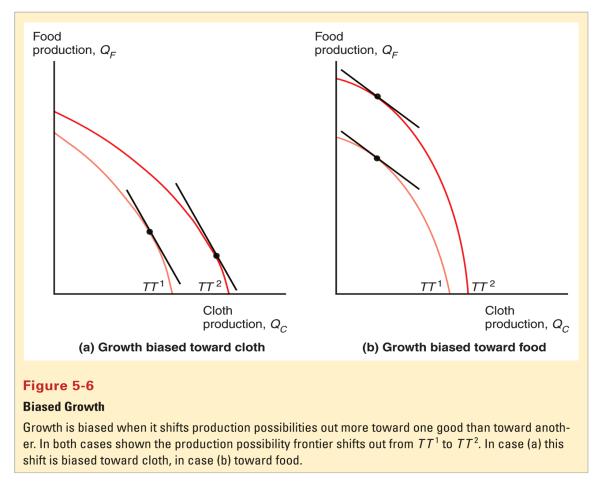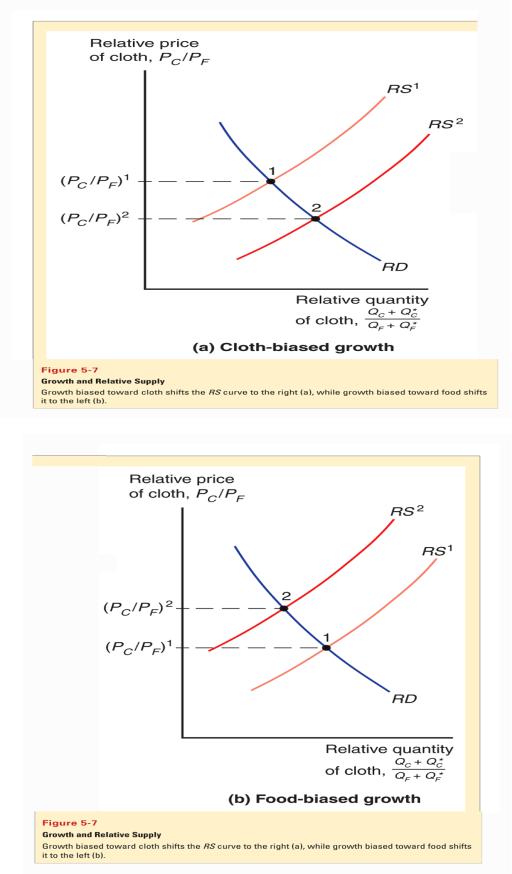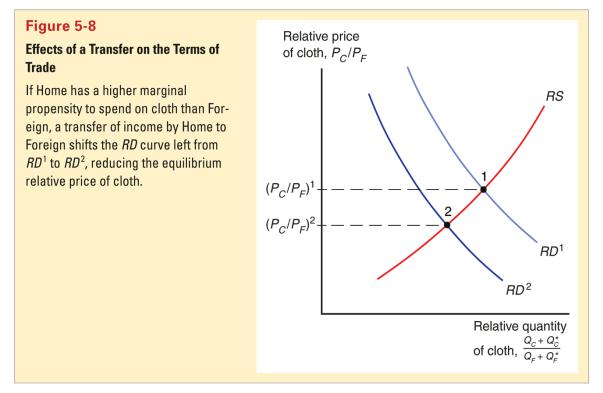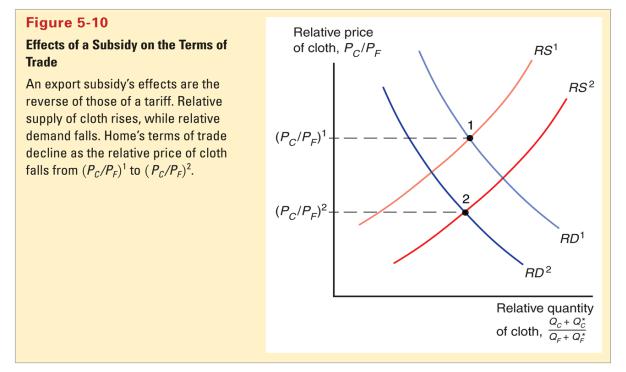
10483
.pdf
 Biased growth and the resulting shift in relative supply causes a change in the terms of trade.
Biased growth and the resulting shift in relative supply causes a change in the terms of trade.
Biased growth in the cloth industry (in either the domestic or foreign country) will lower the relative price of cloth and lower the terms of trade for cloth exporters.
Biased growth in the food industry (in either the domestic or foreign country) will raise the relative price of cloth and raise the terms of trade for cloth exporters.
Suppose that the domestic country exports cloth and imports food.
71

72

 Export-biased growth is growth that expands a country’s PPF disproportionally in production of that country’s exports.
Export-biased growth is growth that expands a country’s PPF disproportionally in production of that country’s exports.
Biased growth in the food industry in the foreign country is export-biased growth for the foreign country.
 Import-biased growth is growth that expands a country’s PPF disproportionally in production of that country’s imports.
Import-biased growth is growth that expands a country’s PPF disproportionally in production of that country’s imports.
Biased growth in cloth production in the foreign country is import-biased growth for the foreign country.
 Export-biased growth reduces a country’s terms of trade, generally reducing its welfare and increasing the welfare of foreign countries.
Export-biased growth reduces a country’s terms of trade, generally reducing its welfare and increasing the welfare of foreign countries.  Import-biased growth increases a country’s terms of trade, generally increasing its welfare and decreasing the welfare of foreign countries.
Import-biased growth increases a country’s terms of trade, generally increasing its welfare and decreasing the welfare of foreign countries.
Has Growth in Asia Reduced
the Welfare of High Income Countries?
 The standard trade model predicts that import biased growth in China reduces the US terms of trade and the standard of living in the US.
The standard trade model predicts that import biased growth in China reduces the US terms of trade and the standard of living in the US.
Import biased growth for China would occur in sectors that compete with US exports.
 But this prediction is not supported by data: there should be negative changes in the terms of trade for the US and other high income countries.
But this prediction is not supported by data: there should be negative changes in the terms of trade for the US and other high income countries.
In fact, the terms of trade for high income countries have been positive and negative for developing Asian countries.
73

The Effects of
International Transfers of Income
 Transfers of income sometimes occur from one country to another.
Transfers of income sometimes occur from one country to another.
War reparations or foreign aid may influence demand for traded goods and therefore relative demand.
International loans may also influence relative demand in the short run, before the loan is paid back.
 How do transfers of income across countries affect relative demand and the terms of trade?
How do transfers of income across countries affect relative demand and the terms of trade?
 If the domestic country generates national income for transfers by
If the domestic country generates national income for transfers by
increasing the price of imports to reduce their purchases and by decreasing the price of exports to increase their sales,
the relative demand curve should shift left and the terms of trade would fall.
74

 But after the transfer of income from the domestic country,
But after the transfer of income from the domestic country,
demand for foreign goods could fall in the domestic country and demand for domestic goods could rise in the foreign country,
so the relative demand curve might not shift left and the terms of trade might not fall.
 How much does demand for domestic goods increase in the foreign country when it receives a transfer of income from the domestic country?
How much does demand for domestic goods increase in the foreign country when it receives a transfer of income from the domestic country?
If the foreign country has a higher marginal propensity to spend on its own goods than on imports, demand for its own goods will rise more than demand for imports from the domestic country.
How much does demand for foreign goods decrease in the domestic
country when it reduces its income through a transfer?
If the domestic country has a higher marginal propensity to spend on its own goods than on imports, demand for its own goods will fall more than demand for imports from the foreign country.
If each country has a higher marginal propensity to spend on its own products, the relative demand curve would shift left after a transfer of income from the domestic country.
 In fact, countries spend most of their (marginal) income on their own products.
In fact, countries spend most of their (marginal) income on their own products.
Americans spend only 11% of national income on imports and 89% on domestically produced goods.
 Transportation costs, tariffs, and other barriers cause domestic residents to favor domestic goods.
Transportation costs, tariffs, and other barriers cause domestic residents to favor domestic goods.
 We predict that the relative demand curve will shift left with a transfer of income, decreasing the terms of trade for the donor nation.
We predict that the relative demand curve will shift left with a transfer of income, decreasing the terms of trade for the donor nation.
75
 In addition, the existence of non-traded goods and services may cause relative supply shifts that reinforce the decrease in the terms of trade for a donor country.
In addition, the existence of non-traded goods and services may cause relative supply shifts that reinforce the decrease in the terms of trade for a donor country.
Industries that produce non-traded goods and services compete for resources with industries that produce traded goods.
A transfer of income from a donor country will reduce demand for and production of non-traded goods in the donor country, so that these resources can be used in its export sector.
The supply of exports relative to imports in the donor country increases, reducing the terms of trade for the donor country.
A transfer of income from a donor country will increase demand for and production of non-traded goods in foreign countries, so that fewer resources can be used in its export sector.
The supply of exports relative to imports in the foreign country decreases, reducing the terms of trade for the donor country.
Import Tariffs and Export Subsidies
 Import tariffs are taxes levied on imports
Import tariffs are taxes levied on imports
 Export subsidies are payments given to domestic producers that export.
Export subsidies are payments given to domestic producers that export.
 Both policies influence the terms of trade and therefore national welfare.
Both policies influence the terms of trade and therefore national welfare.
 Import tariffs and export subsidies drive a wedge between prices in world markets (or external prices) and prices in domestic markets (or internal prices).
Import tariffs and export subsidies drive a wedge between prices in world markets (or external prices) and prices in domestic markets (or internal prices).
 The terms of trade refers to the relative value of a country’s exports and a country’s imports.
The terms of trade refers to the relative value of a country’s exports and a country’s imports.
76

Since exports and imports are traded in world markets, the terms of trade measures external prices.
Import Tariffs and Distribution of Income Across Countries
 If the domestic country imposes a tariff on food imports, the price of food relative to price cloth that domestic citizens face is higher.
If the domestic country imposes a tariff on food imports, the price of food relative to price cloth that domestic citizens face is higher.
Likewise, the price of cloth relative to the price of food that domestic consumers and producers pay is lower.
Domestic producers will receive a lower relative price of cloth, and therefore will be more willing to switch to food production: the relative supply curve will shift.
Domestic consumers will pay a lower relative price of cloth, and therefore be more willing to switch to cloth consumption: the relative demand curve will shift.
 When the domestic country imposes an import tariff, the terms of trade increases and the welfare of the country may increase.
When the domestic country imposes an import tariff, the terms of trade increases and the welfare of the country may increase.
 The magnitude of this effect depends on the size of the domestic
The magnitude of this effect depends on the size of the domestic
country relative to the world economy.
77

If the country is small part of the world economy, its tariff (or subsidy) policies will not have much effect on world relative supply and demand, and thus on the terms of trade.
But for large countries, a tariff rate that maximizes national welfare at the expense of foreign countries may exist.
Export Subsidies and Distribution of Income Across Countries
 If the domestic country imposes a subsidy on cloth exports, the price of cloth relative to price food that domestic citizens face is higher.
If the domestic country imposes a subsidy on cloth exports, the price of cloth relative to price food that domestic citizens face is higher.
Domestic producers will receive a higher relative price of cloth, and therefore will be more willing to switch to cloth production: the relative supply curve will shift.
Domestic consumers will pay a higher relative price of cloth, and therefore be more willing to switch to food consumption: the relative demand curve will shift.
78
 When the domestic country imposes an export subsidy, the terms of trade decreases and the welfare of the country decreases to the benefit of the foreign country.
When the domestic country imposes an export subsidy, the terms of trade decreases and the welfare of the country decreases to the benefit of the foreign country.
Import Tariffs, Export Subsidies and Distribution of Income Across
Сountries
 The two country, two good model predicts that
The two country, two good model predicts that
an import tariff by the domestic country can increase domestic welfare at the expense of the foreign country.
an export subsidy by the domestic country reduces domestic welfare to the benefit of the foreign country.
Import Tariffs and Export Subsidies in Other Countries
 But we have ignored the effects of tariffs and subsidies that occur in a world with many countries and many goods:
But we have ignored the effects of tariffs and subsidies that occur in a world with many countries and many goods:
A foreign country may subsidize the export of a good that the US also exports, which will reduce its price in world markets and decrease the terms of trade for the US.
The EU subsidizes agricultural exports, which reduce the price that American farmers receive for their goods in world markets.
A foreign country may put a tariff on an imported good that the US also imports, which will reduce its price in world markets and increase the terms of trade for the US.
 Export subsidies by foreign countries on goods that
Export subsidies by foreign countries on goods that
the US imports reduce the world price of US imports and increase the US terms of trade.
79
the US also exports reduce the world price of US exports and decrease the US terms of trade.
 Import tariffs by foreign countries on goods that
Import tariffs by foreign countries on goods that
the US exports reduce the world price of US exports and decrease the US terms of trade.
the US also imports reduce the world price of US imports and increase the US terms of trade.
Import Tariffs and Export Subsidies
 Export subsidies on a good decrease the relative world price of that good by increasing relative supply of that good and decreasing relative demand of that good.
Export subsidies on a good decrease the relative world price of that good by increasing relative supply of that good and decreasing relative demand of that good.
 Import tariffs on a good decrease the relative world price of that good (and increase the relative world price of other goods) by increasing the relative supply of that good and decreasing the relative demand of that good.
Import tariffs on a good decrease the relative world price of that good (and increase the relative world price of other goods) by increasing the relative supply of that good and decreasing the relative demand of that good.
Import Tariffs, Export Subsidies and Distribution of Income Within a
Country
 Because of changes in relative prices, import tariffs and export subsidies have effects on income distribution among producers within a country.
Because of changes in relative prices, import tariffs and export subsidies have effects on income distribution among producers within a country.
 Generally, a domestic import tariff increases income for domestic importcompeting producers by allowing the price of their goods to rise to match increased import prices, and it shifts resources away from the export sector.
Generally, a domestic import tariff increases income for domestic importcompeting producers by allowing the price of their goods to rise to match increased import prices, and it shifts resources away from the export sector.
 Generally, a domestic export subsidy increases income for domestic exporters, and it shifts resources away from the import-competing sector.
Generally, a domestic export subsidy increases income for domestic exporters, and it shifts resources away from the import-competing sector.
80
